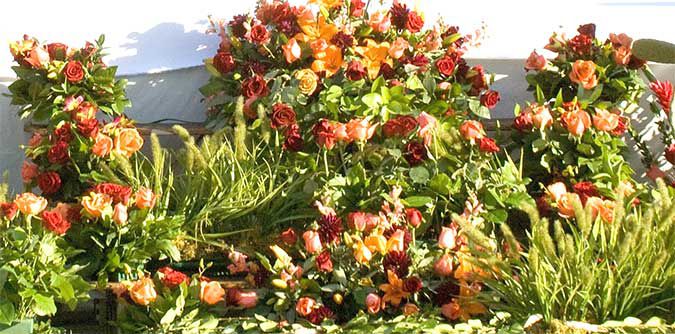The Christmas Muzak playing in stores since before Thanksgiving has been silenced. Shelves have shed their tinsel and plastic holly. For retailers the Christmas season is over.
The Catholic Church, however, the inventor of Christmastide, continues to celebrate the Nativity of her Savior throughout 40 days, ending February 2. Catholic legends surround the birth of Jesus connecting several kinds of plants to the annual celeÙbration. Follow along as Yours Festively describes flowers, herbs and spices associated with the birth of Jesus and His early childhood.
Saints Matthew and Luke, writing catechetically rather than biographically, are rather crisp in their birth narratives. Christians began wondering what might have taken place when Jesus was born, inventing tales about what they called “Cradle Herbs and Flowers,” perhaps as bedtime stories --- many certainly read as such --- to show how the Earth rejoiced at God’s Incarnation.
Arriving in Bethlehem, Joseph, it was said, gathered masses of grasses from the fields surrounding the stable so he might provide Mary a comfortable place on which to rest. Upon this soft, fragrant bed she gave birth to her firstborn Son, God Almighty, who humbled Himself to be made man. This event was betokened by the grasses which made up Mary’s sweet-smelling couch, the Wild Thyme, symbolizing strength, and Sweet Woodruff, representing humility.
To welcome Mary’s Baby, the white flowers of Laurel burst open to reveal a brilliant gold within when He was laid upon them. Sweet-smelling Sainfoin (Onobrychis viciaefolia) a legume greatly enjoyed by both sheep and cattle, bloomed to form a decorative halo of pink flowers to wreathe the Christ Child's head. Outside, where the light from the Star struck the ground, it burst into vast multitudes of tiny flowers known now as “Stars of Bethlehem.”
The Legend of the Christmas Rose takes two forms. In the English version, a white rose in Nazareth, hearing that Mary was chosen to be the Mother of God, blushed pink when Mary agreed. The French story is more extensive.
A poor, young shepherdess named Madelon accompanied her father to the stable to see the Baby Jesus but, seeing the gold, frankincense and myrrh of the Magi she sadly realized she had no present for the newborn Messiah. Saddened, the girl turned away weeping. Her guardian angel watched the tears fall on the ground. With a wave of his arm, the ground shook gently as a rosebush quickly grew and bloomed radiant white flowers.
"Not gold, nor myrrh, nor frankincense,” the angel told Madelon, "is an offering greater than these pure roses. Take them to the Son of God.”
Madelon gathered the flowers and rushed back to the stable, placing the roses beside the Child in the manger. Smiling at Madelon, the Baby Jesus reached out to touch the blossoms and the white roses turned pink. This story may have influenced the writing of the tender Christmas carol, “Lo, How a Rose E’er Blooming.”
For centuries English Ivy has been used extensively in Europe for asthma and other symptoms of respiratory illnesses and congestion. It was said that Ivy climbed the walls of the cave in which Jesus was born so it might behold the Child. Ivy must cling to a support in order to grow, just as Christians need to cling to God for support in this life to behold Him in the hereafter. Ivy growing on the walls of churches, it was believed, protected them from lightning.
We mentioned the blossoms of Laurel, aka Bay, as a Cradle Herb. Wreaths of Laurel, whose leaves are often used in cooking, crowned the brows of Roman generals and emperors during magnificent triumphs, honoring their victories in battle. Medieval herbology called Laurel “Our Lady’s Bedstraw.”
The leaves were dried, stuffed into ticking and used for mattresses. It was believed that the Virgin laid her Child on soft Laurel blossoms in the manger. The Laurel symbolizes Christ’s victory over Satan, a triumph begun with His Incarnation. The herb found its way into a joyous carol:
“Christ was born on Christmas Day;
Wreathe the Holly, twine the Bay;
Christus natus hodie!
The Babe, the Son, the Holy One of Mary.”
According to French tradition, Mistletoe was the tree from which the Cross was made so it was cursed and degraded by God, denied its own place to live and grow on Earth, condemned forever to be a parasite on trees and poisonous to humans --- hardly a corÙdial pedigree to associate Mistletoe with Christmas.
But it should be recalled that Druids cut the Mistletoe from oaks with little golden sickles for use in fertility rites. Also, warring Norse warriors made peace by laying down their arms under a growth of Mistletoe. It’s possible that, in teaching the people to reject Druidism, Christian missionaries vilified the plant so revered by pagans. It may also be that the French in Normandy, so often overrun by Viking marauders bent on pillage and plunder, reÙtaliated by belittling the plant so venerated by their enemies.
Still, the older traditions prevailed and, by the High Middle Ages, Mistletoe became the central feature of Kissing Rings suspended in the archways of homes during Yuletide.
Sean M. Wright, a member of Our Lady of Perpetual Help in Santa Clarita, conducts workÙshops and enrichment courses at parÙishes in the archdiocese on the Holy Eucharist, Catholic symbolism, art and related topics. He replies to emails sent him at LockÙ[email protected].

